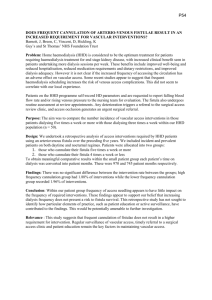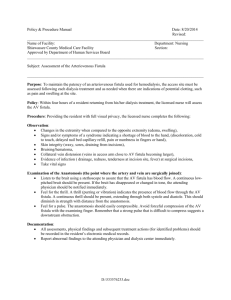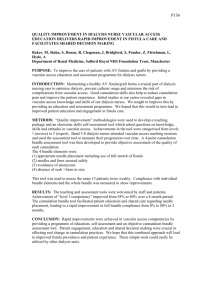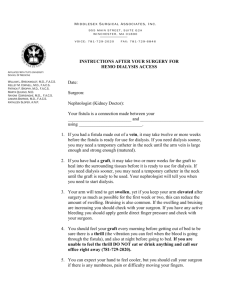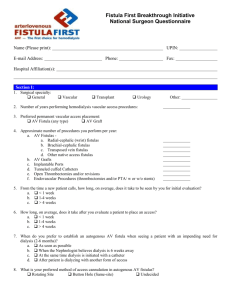Document 13444459
advertisement
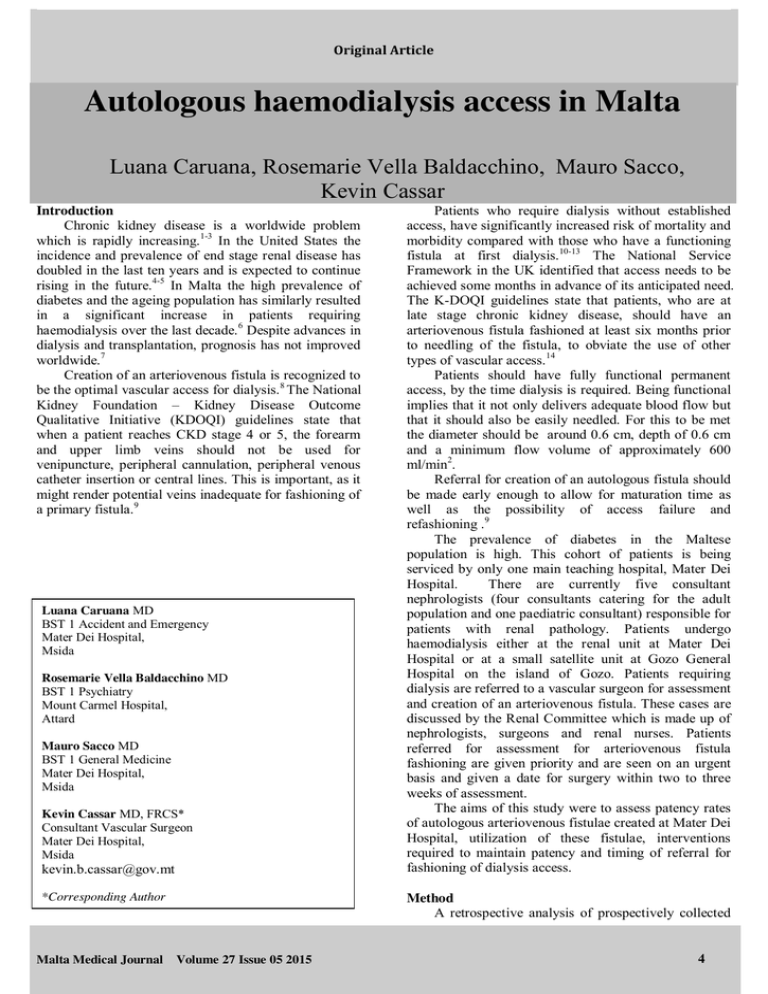
OEdArticle Original Autologous haemodialysis access in Malta Luana Caruana, Rosemarie Vella Baldacchino, Mauro Sacco, Kevin Cassar Introduction Chronic kidney disease is a worldwide problem which is rapidly increasing.1-3 In the United States the incidence and prevalence of end stage renal disease has doubled in the last ten years and is expected to continue rising in the future.4-5 In Malta the high prevalence of diabetes and the ageing population has similarly resulted in a significant increase in patients requiring haemodialysis over the last decade. 6 Despite advances in dialysis and transplantation, prognosis has not improved worldwide.7 Creation of an arteriovenous fistula is recognized to be the optimal vascular access for dialysis. 8 The National Kidney Foundation – Kidney Disease Outcome Qualitative Initiative (KDOQI) guidelines state that when a patient reaches CKD stage 4 or 5, the forearm and upper limb veins should not be used for venipuncture, peripheral cannulation, peripheral venous catheter insertion or central lines. This is important, as it might render potential veins inadequate for fashioning of a primary fistula.9 Luana Caruana MD BST 1 Accident and Emergency Mater Dei Hospital, Msida Rosemarie Vella Baldacchino MD BST 1 Psychiatry Mount Carmel Hospital, Attard Mauro Sacco MD BST 1 General Medicine Mater Dei Hospital, Msida Kevin Cassar MD, FRCS* Consultant Vascular Surgeon Mater Dei Hospital, Msida kevin.b.cassar@gov.mt *Corresponding Author Malta Medical Journal Patients who require dialysis without established access, have significantly increased risk of mortality and morbidity compared with those who have a functioning fistula at first dialysis.10-13 The National Service Framework in the UK identified that access needs to be achieved some months in advance of its anticipated need. The K-DOQI guidelines state that patients, who are at late stage chronic kidney disease, should have an arteriovenous fistula fashioned at least six months prior to needling of the fistula, to obviate the use of other types of vascular access.14 Patients should have fully functional permanent access, by the time dialysis is required. Being functional implies that it not only delivers adequate blood flow but that it should also be easily needled. For this to be met the diameter should be around 0.6 cm, depth of 0.6 cm and a minimum flow volume of approximately 600 ml/min2. Referral for creation of an autologous fistula should be made early enough to allow for maturation time as well as the possibility of access failure and refashioning .9 The prevalence of diabetes in the Maltese population is high. This cohort of patients is being serviced by only one main teaching hospital, Mater Dei Hospital. There are currently five consultant nephrologists (four consultants catering for the adult population and one paediatric consultant) responsible for patients with renal pathology. Patients undergo haemodialysis either at the renal unit at Mater Dei Hospital or at a small satellite unit at Gozo General Hospital on the island of Gozo. Patients requiring dialysis are referred to a vascular surgeon for assessment and creation of an arteriovenous fistula. These cases are discussed by the Renal Committee which is made up of nephrologists, surgeons and renal nurses. Patients referred for assessment for arteriovenous fistula fashioning are given priority and are seen on an urgent basis and given a date for surgery within two to three weeks of assessment. The aims of this study were to assess patency rates of autologous arteriovenous fistulae created at Mater Dei Hospital, utilization of these fistulae, interventions required to maintain patency and timing of referral for fashioning of dialysis access. Method A retrospective analysis of prospectively collected Volume 27 Issue 05 2015 4 OEdArticle Original data of patients who underwent primary fashioning of an autologous arteriovenous fistula, under the care of one vascular surgeon at Mater Dei Hospital, between October 2012 and May 2014 was performed. Data collected included demographics (gender and age), major risk factors for arterial disease (smoking, hypertension, hypercholesterolemia, diabetes and ischemic heart disease), presence of coagulation disorders, estimated glomerular filtration rate at time of referral, time period when fistula was fashioned, whether the patient was already on dialysis prior to surgery and type of fistula created. This data was collected prospectively and recorded in a vascular database. Other data collected included type of autologous AV fistula created. Details on maturation, patency, usability, successful cannulation and measurement of fistulae (diameter, depth, flow volume and peak systolic velocity (PSV)) was also recorded. Details on any reinterventions that were required were also recorded. The case files were reviewed at the Renal Unit, between August and September 2014 to identify the maturation, patency, usability, success of cannulation and any problems encountered before and after cannulation. Case files of deceased patients were reviewed, at the Mater Dei Hospital Medical Records, in September 2014 to identify the cause and the time lapse from fistula creation to the date of demise. A proforma was constructed to ensure thorough comprehensive data gathering. All data was finally inputted in an excel sheet and coded for easier data analysis. Results Between October 2012 and May 2014, sixty eight patients underwent primary fashioning of an autologous arteriovenous fistula. Forty nine (72.1%) were male. The mean age was 60.9 years with a range from 14 to 90 years. As illustrated in figure 1 eleven patients (16.2%) passed away during the study period with a median follow up of 14 weeks and a range from three days to fifty two weeks. Of these eleven, three (27.3%) passed away in the early post-operative period (within 30 days) as a result of myocardial infarctions or pulmonary embolism. Sixteen (23.5%) were current or previous smokers, sixty (88.2%) were known hypertensive on treatment, thirty seven (54.4%) had hypercholesterolemia and eighteen (26.5%) were known to suffer from ischemic heart disease having undergone previous surgery or percutaneous coronary intervention. Thirty eight (55.8%) patients were diabetic; of these three (7.89%) were diet controlled, nineteen (50%) were on oral hypoglycaemic agents and sixteen (42.1%) on insulin. Six (8.82%) were on anti-coagulation treatment upon referral. Malta Medical Journal Volume 27 Issue 05 2015 Figure 1: Graph showing outcome versus number of patients Passed away 11 Living 57 0 20 40 60 Number of patients The mean estimated glomerular filtration rate (eGFR) at referral was 11.9 mls/min/1.73m2 with a range from 5-35mls/min/1.73m2. The vast majority, fifty one (75%), were already on dialysis at referral. Thirty seven (72.5%) were dialysed through a central venous catheter and fourteen (27.59%) via peritoneal dialysis. Nine (13.2%) had a fistula fashioned six months before initiation of dialysis while eight (11.8%) had a fistula created within six months of commencing dialysis (Figure 3). Only 25% had a functioning fistula at the time of initiation of dialysis. All patients were examined preoperatively and also underwent duplex scanning of the upper limbs. Of the arteriovenous fistulae created, forty nine (72.1%) were brachiocephalic, ten (14.7%) radio cephalic fistulae, six (8.82%) transposed brachiobasilic fistulae, two (2.94 %) ulnar cephalic fistulae and one (1.47%) snuff box fistula, as shown in figure 2. Figure 2: Type of AV Fistulae fashioned 5 OEdArticle Original Excluding those patients who passed away in the immediate post-operative period, forty three fistulae (66.2%) matured by six weeks while twenty two did not (33.8%). The median follow up was of thirty eight weeks with a range from three weeks to eighty nine weeks. Fifty four fistulae (83.1%) were patent and forty nine (75.4%) were successfully cannulated. To date six fistulae (9.23%) were not used. Excluding those six fistulae and those that passed away in the immediate post-operative period, forty seven fistulae (79.7%) had successful first time cannulation while twelve (20.3%) did not. Twenty nine (44.6%), did not require any subsequent interventions. Eight fistulae (12.3%) required interventions before cannulation, twenty (30.7%) after cannulation and two (3.07%) needed both. As shown in table 1, before cannulation three required endovascular interventions, four open surgery and one needed both. After cannulation fourteen fistulae required endovascular interventions, five open surgery and one needed both. Figure 3: Status of patients upon referral of fashioning of AV fistula Within 6 months of commencing dialysis 8 6 months before dialysis 9 Already on dialysis 51 0 10 20 30 40 50 60 The autologous fistulae were assessed using duplex scanning in the early postoperative period to assess for maturation. The measurements were; mean diameter 5.76 mm, mean depth 6.37 mm, flow volume 1.87 L/min and peak systolic volume (PSV) 282.85 m / sec. Table 1: Intenterventions prior and after cannulation (Excluding two patients that needed intervention both before and after cannulation) Before Cannulation Number of patients Endovascular Repair Open Repair Needing Both Endovascular Repair Open Repair Needing Both 3 4 1 14 5 1 Discussion The patency rates of autologous arteriovenous fistulae fashioned at Mater Dei Hospital (83.1%) are comparable to those reported in the literature (between 43% and 85% one year patency).15-17 Locally the majority of patients (75%) were already on some form of renal replacement therapy when referred for fistula creation with the majority being dialysed through a central venous catheter. The mean eGFR was 11.9 mls/min/1.73m2 at referral indicating late referral. Early referral for fashioning of an arteriovenous fistula is recommended both by K-DOQI guidelines as well as local National Service Frameworks. Lack of a usable fistula for dialysis necessitates insertion of temporary lines which is associated with a significant increase in morbidity and mortality in this cohort of high risk patients. Malta Medical Journal After Cannulation Volume 27 Issue 05 2015 In the majority of patients the timing of dialysis requirement can be predicted, while in a small proportion this is not possible. Referral as early as one year prior to predicted requirement for dialysis, ensures that there is adequate time for fashioning and maturation of an AV fistula as well as the possibility of failure and refashioning. This obviates the need for potentially dangerous insertion of central venous catheters and their associated complications, particularly line sepsis, bacteraemia and mortality in the short-term and the long-term complications of central vein stenosis and occlusions. Early referral also ensures that acute admissions to hospital secondary to line complications are reduced and therefore unnecessary cannulation of arm veins with resultant loss of dialysis access possibilities is avoided. Furthermore in those patients who are already on 6 Original Article OEd haemodialysis, once the AV fistula is created there is often pressure for early cannulation before adequate maturation of the fistula is achieved. There is clear evidence that early needling leads to a higher rate of fistula failure.8 Late referral of patients also results in a significant number of unnecessary interventions by interventional radiologists such as insertion of tunnelled lines, which could be avoided. This implies unnecessary utilisation of scarce resources from other departments, apart from the patients’ morbidity associated with the additional interventions. The proportion of patients in this study with a functioning AV fistula at time of first dialysis is very low (25%) and certainly well below current recommendations. Reasons for this may include delay in diagnosis due to inadequate primary care facilities, inappropriate delay in referral to tertiary hospital, reluctance by patients to be referred, patient failure to accept dialysis or dialysis access, service provision pressures to increase peritoneal dialysis use, bureaucratic delays, poor communication between physicians and surgeons, and other factors. Further studies need to be carried out to identify the causes of delay in referral in order to improve the current quality of care. 8. 9. 10. 11. 12. 13. 14. 15. 16. 17. Rayner HC, Pisoni RL, Gillespie BW, Goodkin DA, Akiba T, Akizawa T, et al. Creation, cannulation and survival of arteriovenous fistulae: Data from the Dialysis Outcomes and Practice Patterns Study. Kidney Int. 2003; 63: 323–30. Clinical practice guidelines and clinical practice recommendations. NKF KDOQI Guidelines [Internet]; 2006 [cited 2014 Oct 20]. Available from: https://www.kidney.org/professionals/guidelines Dhingra RK, Young EW, Hulbert-Shearon T, Leavey SF, Port FK. Type of vascular access and mortality in US hemodialysis patients. Kidney Int. 2001; 60(4):1443-51. Lacson E Jr, Lazarus JM, Himmelfarb J, Ikizler TA Hakim RM. Balancing fistula first with catheters last. Am J Kidney Dis. 2007; 50(3):379-95. Wasse H, Kutner N, Zhang R, Hunag Y. Association of initial hemodialysis vascular access with patient reported health status and quality of life. Cli J Am Soc Nephron. 2007; 2(4):708-714. Perl J, Wald R, McFarlane P. Hemodialysis vascular access modifies the association between dialysis modality and survival. J Am Soc Nephron. 2011; 22(6):1113-21. Kimball TA, Barz K, Dimond K, Edwards J, Nehler MR. Efficiency of the KDOQI Guidelines for Vascular Access in an Academic Setting. Journal of Vascular Surg. 2010; 52(2): 527. Suttie SA, Ponnuvelu G, Henderson N, Vint R, Ross R, Tootill R, Howd A, Nagy J, Griffiths GD. Natural history of upper limb arteriovenous fistulae for chronic dialysis. J Vasc Access. 2012; 13(3):332-7. Eisharawy MA. Prospective evaluation of factors associated with early failure of arteriovenous fistulae in hemodialysis patients. Vascular 2006; 14(2):70-4. Dixon BS, Novak L, Fangman J. Hemodialysis vascular access survival: upper arm native arteriovenous fistulae. Am J Kidney Dis. 2002; 39(1):92-101. References 1. 2. 3. 4. 5. 6. 7. Rhee CM, Kovesdy CP. Epidemiology: spotlight on CKD deaths - increasing mortality worldwide, Nat Rev Nephrl 2015; 11(4):199-200. Hossain MP, Dodder EC, Rigby JE, El Nahas M. CKD and poverty: a growing global challenge. Am J Kidney Dis 2009; 53(1):166-74. Mills KT, Xu Y, Zhang W, Bundy JD, Chen CS, Kelly TN, Chen J, He J. A systematic analysis of worldwide populationbased data on the global burden of chronic kidney disease in 2010. Kidney Int 2015; koi: 10.1038/ki.2015.230. Centers for Disease Control and Prevention. Chronic Kidney Disease Surveillance System, Atlanta, Atlanta, GA: Centers for Disease Control and Prevention, US Dept of Health and Human Services [Internet]; 2011 [cited 2014 Oct 22]. Available from: http://www.cdc.gov/ckd. US Renal Data System. USRDS 2013 Annual Data Report: Atlas of chronic Kidney Disease and End-stage renal Disease in the United States. Bethesda, MD: National Institutes of Health, National Institute of Diabetes and Digestive and Kidney Disease[Internet];2013[cited 2014 Oct 25]. Available from: http://www.usrds.org/atlas.aspx. Guariguata L, Nolan T, Beagley J, Linnenkamp U, Jacqmain O editors. International Diabetes Federation Diabetes Atlas [Internet]; 2014 [cited 2014 Oct 20]. Available from: http://www.idf.org. Schoolwerth AC, Engelgau MM, Hostetter TH. A public health action plan is needed for chronic kidney disease. Adv Chronic Kidney Dis 2005; 12:418-23. Malta Medical Journal Volume 27 Issue 05 2015 7
